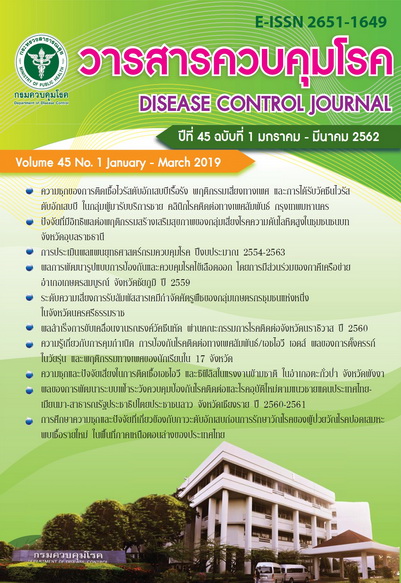Development of prevention and control measures for dengue hemorrhagic fever by participation of network partners in Kaset Sombun District, Chaiyaphum Province
DOI:
https://doi.org/10.14456/dcj.2019.14Keywords:
Dengue Hemorrhagic Fever, network partners, participationAbstract
In 2015 the highest number of patients with Dengue Hemorrhagic Fever (DHF) in a decade was reported in Kaset Sombun district. Contributing factors associated with the high incidence of DHF included chemicals used were not effective; local residents did not eliminate Aedes mosquito breeding in and around their household; and network partners did not take disease prevention very seriously. Thus, a participatory approach was developed to ensure more active engagement by the network partners in an attempt to strengthen the prevention and control of DHF using the action research. The objective of the research was to study the outcomes of the development and implementation of preventive and control measures for DHF by focusing on participation of network partners. The research instruments included a mosquito larva survey form and national disease surveillance report form (Report 506). The descriptive statistics were percentage, median, minimum, and maximum. The inferential statistics were Mann Whitney-U test and Wilcoxon rank-sum test. It was found that the network partners were actively involved in the formulation of the district-level policies. Emphasis was placed on eliminating Aedes mosquito breeding using physical and biological methods. The local public health agency made an evaluation on each village’s efforts to make their neighborhood tidy and clean and get rid of Aedes breeding three times per year as part of the contest for clean and Aedes breeding-free village In addition, results from these evaluations were reported back to the local network partners, indicating the level of risks for DHF in each village. This resulted in effective implementation of disease prevention and control efforts specifically for the local circumstances of each sub-district and village. During the implementation period, the local network partners were assigned specific roles and responsibilities, i.e. village health volunteers and community leaders worked on the efforts to get rid of Aedes mosquito breeding, while local administration organizations provided funding support and chemical supplies for the purposes of diseases. Based on the survey, it was found the villagers had paid more attention on eliminating Aedes breeding in and around their houses, as evidenced by people making a lid to cover water jars using bamboo and fine green mesh. In some villages, these water jar covers were even made by village health volunteers and community leaders for free distribution to the villagers. Besides, the local fish (gourami) was also released into water containers to help get rid of mosquito larvae. The fish can easily be found in natural water sources, thus leading to a more lasting disease prevention and control effort and a reduction in chemical use. The median of House Index (HI) in 2015 was 10.0 (Min-Max = 2.5-32.5), in 2016 was 7.5 (Min-Max = 0.0-20.0), which means the value in 2015 was higher than that in 2016, with a statistical significance of 0.05 (p<0.001). The median of DHF morbidity rate per 100,000 populations in 2015 was 192.6 (Min-Max = 0.0-899.1), in 2016 was 0.0 (Min-Max = 0.0-468.4). That means the value in 2015 was higher than that in 2016, with a statistical significance of 0.05 (p<0.001). In summary, the number of DHF cases and House Index (HI) in 2016 was lower than that of 2015. This was primarily due to active participation from the local network partners, implementation of prevention and control measures suitable for the local settings, and effective evaluation system that can provide feedbacks to the local network partners. All these have contributed to an increased awareness and cooperation to ensure effective prevention and control of DHF.
Downloads
References
2. Bureau of Vector-Borne Diseases. Dengue Hemorrhagic Fever situation in 2015 [Internet]. [cited 2015 Nov 10]. Available from: https://ddc.moph.go.th/th/site/office_newsview/ view/696 (in Thai)
3. Chaiyaphum Provincial Health Office. Dengue Hemorrhagic Fever situation in Chaiyaphum Province in 2015 [Internet]. [cited 2015 Nov 10]. Available from: http://cpho.moph.go.th/wp/wp-content/uploads/2012/08/week-482.pdf (in Thai)
4. Bureau of Epidemiology. Applied epidemiology for prevention and control of D.H.F. Samut Songkhram: Born to be publishing; 2017. (in Thai)
5. Ramkhamhaeng University. The participation in the work of personnel [Internet]. [cited 2015 Nov 10] Available from: http://hrm.ru.ac.th/file/research/005-5.pdf (in Thai)
6. Shuaytong P, Suphun B, Karuhadej P. The People participation on Dengue Hemorrhagic Fever prevention and control in Si Sa Ket Province. Kuakarun Journal of Nursing 2013;20:55-69. (in Thai)
7. Kiatthanabodi P, Wiwanitkit V, Deeying J. Prevention and control behaviors on Dengue Hemorrhagic Fever of party health network in Muang District, Buri Ram Province. Journal of Research and Development Buri Ram Rajabhat University 2015;10:84-91. (in Thai)
8. Wannasamphat P. Development of prevention and control of Dengue Fever by the process of five networks, five collaborations, five attributions in Muang District, Yasothorn. Journal of Health Science 2015;24:1096-106 (in Thai)
9. Sota C. Concepts theories and application for health behavioral development. 3rd ed. Khon Kaen: Khon Kaen University; 2011. (in Thai)
Downloads
Published
How to Cite
Issue
Section
License
Articles published in the Disease Control Journal are considered as academic work, research or analysis of the personal opinion of the authors, not the opinion of the Thailand Department of Disease Control or editorial team. The authors must be responsible for their articles.






